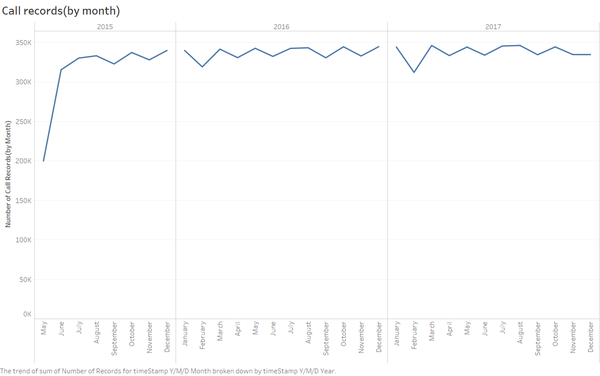Difference between revisions of "Insights"
| Line 36: | Line 36: | ||
The Waterway sample readings taken by the hydrology department shows an different pattern in the data collection in the past and recent years among the chemicals. The number of records every month taken by the sensors and monitors are different for each chemical. As shown below there are broadly five categories of data collection by the hydrology department:<br> | The Waterway sample readings taken by the hydrology department shows an different pattern in the data collection in the past and recent years among the chemicals. The number of records every month taken by the sensors and monitors are different for each chemical. As shown below there are broadly five categories of data collection by the hydrology department:<br> | ||
1. <b> Complete Data:</b> These chemicals have data from the year 1998 – 2016 taken by the hydrology department. Even though the number of readings are different across the years, they have the complete pattern to detect the trends and anomalies. These are chemicals like Ammonium, Magnesium, Sodium, Sulphates, Zinc , water temperature.<br> | 1. <b> Complete Data:</b> These chemicals have data from the year 1998 – 2016 taken by the hydrology department. Even though the number of readings are different across the years, they have the complete pattern to detect the trends and anomalies. These are chemicals like Ammonium, Magnesium, Sodium, Sulphates, Zinc , water temperature.<br> | ||
| − | 2. <b>Data Available for Last few years:</b> These chemicals have data for the last few years from 2005-2016 taken by the hydrology department.These chemicals were not considered and recorded in the years before 2005. This pattern is exhibited for the chemicals like Mercury, Total nitrogen, total hardness. | + | 2. <b>Data Available for Last few years:</b> These chemicals have data for the last few years from 2005-2016 taken by the hydrology department.These chemicals were not considered and recorded in the years before 2005. This pattern is exhibited for the chemicals like Mercury, Total nitrogen, total hardness. |
| − | + | <br> | |
| − | |||
| − | |||
| − | [[File:Q1_call.png| | + | |
| + | [[File:Q1_call.png|600px|center]] | ||
<font size = 3; color="#000000"><span style="font-family:Trebuchet MS; font-weight:bold;"><h2>Question 2 :Characterize the past and most recent situation with respect to chemical contamination in the Boonsong Lekagul waterways. Do you see any trends of possible interest in this investigation?</h2></span></font> | <font size = 3; color="#000000"><span style="font-family:Trebuchet MS; font-weight:bold;"><h2>Question 2 :Characterize the past and most recent situation with respect to chemical contamination in the Boonsong Lekagul waterways. Do you see any trends of possible interest in this investigation?</h2></span></font> | ||
Revision as of 18:26, 8 July 2018
|
|
|
|
|
Question 1 :Characterize the past and most recent situation with respect to chemical contamination in the Boonsong Lekagul waterways. Do you see any trends of possible interest in this investigation?
1. Sampling pattern :
The Waterway sample readings taken by the hydrology department shows an different pattern in the data collection in the past and recent years among the chemicals. The number of records every month taken by the sensors and monitors are different for each chemical. As shown below there are broadly five categories of data collection by the hydrology department:
1. Complete Data: These chemicals have data from the year 1998 – 2016 taken by the hydrology department. Even though the number of readings are different across the years, they have the complete pattern to detect the trends and anomalies. These are chemicals like Ammonium, Magnesium, Sodium, Sulphates, Zinc , water temperature.
2. Data Available for Last few years: These chemicals have data for the last few years from 2005-2016 taken by the hydrology department.These chemicals were not considered and recorded in the years before 2005. This pattern is exhibited for the chemicals like Mercury, Total nitrogen, total hardness.

